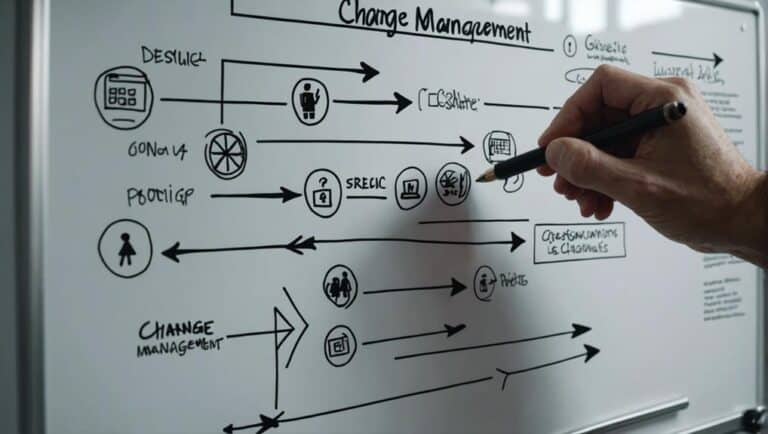Imagine you're a manager dealing with the challenge of leading your team through a big organizational change. Picture this: your company is rolling out a new technology system that will completely transform how things are done, but it's going to require your staff to make some significant adjustments.
As you navigate this change, wouldn't it be helpful to have a detailed guide that gives you practical insights and proven strategies to ensure a smooth change management process? This guide can give you the tools you need to address resistance, promote collaboration, and achieve successful outcomes during times of change.
Key Takeaways
Let's start by painting a clear picture of where we want to go with our change initiatives. We need to get everyone on board, from top management to front-line employees, to ensure we have their buy-in and support. This will help us navigate the changes smoothly and effectively.
It's crucial to involve stakeholders at all levels in the planning process. By getting their input and feedback, we can tailor our change management plan to address their concerns and needs. This collaborative approach will make sure everyone feels heard and valued throughout the process.
Our change management plan should be detailed and well-structured, outlining clear steps and timelines for implementation. This will help us stay organized and focused as we work towards our goals. It's important to keep everyone in the loop by communicating consistently and transparently about the changes ahead.
We also need to provide training, resources, and support to help everyone adapt to the new ways of working. By offering the right tools and guidance, we can set our teams up for success and ensure a smooth transition. Let's make sure we're there for our employees every step of the way as we implement these changes.
Importance of Change Management
Change management is super important for companies to handle shifts successfully and keep growing. Organizational Change Management is key in guiding the company towards its goals while keeping employees engaged. A big part of making change work is explaining why it's needed clearly and consistently to everyone in the company.
Managers need to spell out why changes are happening, show the benefits, and address any worries employees might have. When managers communicate the need for change well, it helps get everyone on board, making it more likely that the changes will work out. Being open about it builds trust and gets everyone moving in the same direction, making the transformation easier.
Organizational Change Management isn't just a step-by-step thing; it's a must-do for businesses that want to do well in today's fast-paced world. By stressing the importance of clear communication and getting everyone on board, managers can kick off change projects that spark innovation and growth.
Aligning People, Strategy, Technology
When you're trying to make big changes in an organization, it's crucial to get everyone on the same page. That means making sure everyone – from top management to frontline employees – is involved in the process. When everyone is working towards the same goals, it makes change easier and more successful.
One key to aligning people, strategy, and technology is clear communication. Keeping everyone updated on progress and milestones helps everyone stay in the loop. It's also important to recognize and reward employees for their hard work and dedication to the change process. This helps solidify everyone's commitment to the changes.
Clear Communication Strategies
When you're making changes in a company, it's super important to communicate clearly. This helps make sure everyone is on the same page and supports the changes. Communication is like the backbone of change management – it keeps everyone in the loop, engaged, and excited about what's happening.
To get your message across, you can use different ways to talk to people, like town hall meetings, emails, or one-on-one chats. This way, you can make sure everyone hears what they need to know in a way that makes sense to them. When you tailor your communication to fit the needs of different groups, it helps them understand better and get on board with the changes. This buy-in is really important for making sure the changes are successful.
Being transparent during times of change is key. By giving updates regularly and asking for feedback, you show that you're open to communication. This builds trust and collaboration, which are essential for keeping everyone connected and working together during the change process.
Employee Engagement Techniques
When your organization is going through changes, it's important to get your employees on board and keep them motivated. How do you do that? Well, by using different techniques that encourage them to be engaged and committed. Employee engagement is crucial for the success of any change management initiative.
So, what can you do to boost employee engagement during times of change? Start by keeping the lines of communication open. Listen to your employees and show that you value their input. Recognize their efforts and give them opportunities to develop new skills. When employees feel engaged, they're more likely to embrace change, which leads to increased productivity, job satisfaction, and lower turnover rates.
By implementing these strategies, you not only create a positive work environment but also boost morale among your employees. Remember, motivated employees are your secret weapon during times of change. Investing in their engagement can make a big difference in the success of your change initiatives.
Prioritizing employee engagement fosters a sense of belonging and commitment, ultimately contributing to the overall success of change management within your organization.
Collaboration in Change Initiatives
When things are changing, it's crucial to get everyone working together – employees, managers, and stakeholders alike. Successful transformation depends on building a culture where people collaborate towards a shared goal. When everyone is involved in the change, you ensure there's agreement, openness, and a feeling of ownership. Having common objectives, clear communication, and teamwork is vital for steering organizational change in the right direction.
Collaboration not only helps make better decisions but also speeds up the implementation of changes, leading to improved outcomes overall. Taking a collaborative approach in cultural change makes sure that different viewpoints are taken into account, relationships are reinforced, and change efforts are sustainable in the long run.
Studies indicate that without effective collaboration, many change efforts in organizations fall short. Therefore, it's crucial to make collaboration a central part of your change management strategy to drive successful and enduring change within your organization.
Regular Updates and Reporting
If you want your change initiatives to succeed, make sure to keep everyone in the loop with regular updates and reports. By tracking progress and sticking to a communication schedule, you can keep stakeholders in the loop and involved.
This approach helps build trust, transparency, and accountability, which are key for making good decisions and achieving your goals.
Progress Tracking Methods
Progress tracking methods are crucial during the change process. Regular updates and reporting help keep everyone in the loop and aid decision-making. Giving regular updates ensures that all team members are on the same page, encourages responsibility, and tracks progress effectively.
Reporting provides facts and figures that enable managers to make informed decisions, identify problems, and celebrate successes. Tools like dashboards, KPIs, and milestone tracking offer visual representations of progress and demonstrate the impact of changes to stakeholders.
Open communication about progress fosters teamwork and engages employees in the change journey. Monitoring progress allows for timely adjustments to facilitate a smooth and successful transition.
Communication Frequency Plan
When it comes to change management, it's important to keep everyone in the loop by regularly updating and reporting on progress. This helps ensure that stakeholders are kept informed and engaged throughout the transformation process. By having a structured communication plan in place within the organization, you can manage expectations, address concerns, and reinforce the vision behind the change initiative.
Here are the key benefits of having a strong communication frequency plan:
- Transparency: This helps to keep things clear and open when sharing information with stakeholders.
- Stakeholder Engagement: By keeping people actively involved and committed, you can get them on board with the changes.
- Alignment Towards Goals: It helps to ensure that everyone is moving in the same direction towards common objectives and organizational outcomes.
Rewarding Contributions and Efforts
When you're dealing with change management, it's really important to recognize and appreciate the contributions your team makes. This is key to keeping them motivated and creating a positive atmosphere.
When you acknowledge the efforts of individuals and teams, it boosts their spirits and helps them stay committed to making the change successful. By offering rewards and incentives, you not only improve performance but also ensure that the organizational change is a long-term success.
Recognition for Hard Work
Organizations can boost employee morale and motivation during change initiatives by recognizing and rewarding hard work and contributions. It's crucial to acknowledge the efforts employees put in during challenging times. This not only boosts morale but also increases engagement and loyalty. When organizations provide incentives and rewards for contributions to change initiatives, it encourages employees to stay committed and dedicated.
Recognizing both individual and team achievements is key to fostering a positive work culture and reinforcing desired behaviors within the organization. By rewarding contributions in change management, organizations show employees that their efforts are valued, which in turn enhances overall performance.
Incentives for Team
Rewarding team contributions and efforts in change management is crucial for building a collaborative culture and keeping motivation high. Giving teams incentives can really boost their spirits and keep them motivated throughout the change journey.
Tailoring rewards to fit what each team member likes, whether it's money or something else, can help keep everyone engaged and dedicated. When you acknowledge and reward the hard work of your team, it not only boosts morale but also creates a positive atmosphere that promotes teamwork.
Well-planned incentive programs are key in encouraging the behaviors and results you want to see in change efforts. By appreciating and rewarding your team's efforts, you foster a supportive environment that encourages everyone to actively take part in the change process, leading to successful outcomes.
Acknowledging Employee Contributions
Recognizing what your employees bring to the table during times of change is super important. It helps create a positive vibe at work and keeps everyone pumped up. When you give props to your team for their hard work, they feel valued and are more likely to jump on board with the changes happening in the company. Things like bonuses or a shoutout in a meeting can really drive home the behaviors you're looking for during these transitions.
Showing your team some love not only makes them feel good but also pushes them to keep getting better at what they do. When you celebrate the wins and milestones along the way, it brings everyone together and boosts morale. Remember, a small thank you or a pat on the back can do wonders in keeping your team motivated and making those changes stick.
Leading Successful Change Initiatives
To make change happen successfully, you need to get everyone on board and moving forward. One way to do this is by creating a sense of urgency. This means showing people why the change is important and getting them excited to be a part of it. Having a clear and inspiring vision for the change can help people see the big picture and get motivated to take action.
It's also crucial to involve key stakeholders early on in the process. These are the people whose support can make or break the success of the change efforts. By getting them on board from the start, you can increase the chances of the initiatives being successful.
Communication is key when it comes to leading change. Being open and honest in your messages and taking the time to listen to others can help build trust and understanding within the team. This, in turn, can help keep everyone motivated and moving in the right direction.
Setting clear goals and celebrating small wins along the way can help keep the momentum going. It's important to give people a sense of progress and achievement as they work towards the larger goals.
Building a strong team with a diverse set of skills and perspectives is also important. This can help ensure that you have the right tools and strategies in place to overcome any challenges that may arise during the change process. By working together and leveraging everyone's strengths, you can increase the chances of success.
Driving Growth Through Change
You can use change as a chance to grow by improving how your organization is set up, how things are done, and what plans you have in place.
When everyone gets on board with new ideas and shows strong leadership during these times of change, it makes managing the change much smoother.
Change as Opportunity
Change can actually help organizations grow and come up with new ideas. It's important to remember that people are at the heart of change, so it's crucial to consider their needs and perspectives.
Here are some ways to make change work for your organization:
First, try to get everyone to see change as a way to make things better. This positive mindset can really help people embrace new ideas and ways of doing things.
Second, create a work environment where employees feel supported and valued. Encouraging them to share their thoughts and feedback can make a big difference in how smoothly change is accepted.
Third, make sure to offer learning and development opportunities so that everyone can keep up with the changes happening around them. This can help people feel more confident and capable in the face of new challenges.
And finally, don't forget to celebrate the wins along the way. Recognizing and acknowledging successes can boost morale and keep everyone motivated throughout the change process.
Embracing Innovation Together
In an organization, embracing innovation together can really help it grow. It nurtures creativity and adaptability among the members.
When it comes to managing change, having a culture that supports collaborative innovation can bring about big advantages. By getting employees to share different perspectives and ideas, organizations can improve their problem-solving skills and become more competitive in the market.
Plus, a culture that values innovation usually leads to higher engagement and job satisfaction among employees, which means they're more motivated. Companies that focus on both innovation and change management are better at dealing with changes in the business world and can grab new growth opportunities.
Leadership in Transition
Being a manager in change management, it's crucial to recognize the significance of effective leadership in navigating transitions within an organization. Here are some key strategies to lead through change:
First off, make sure to guide your teams through the change process to ensure a smooth transition. It's important to align people, processes, and technology towards a common vision. Clear communication, providing direction, and inspiring confidence are essential elements in leading through change.
Additionally, fostering collaboration, building trust, and leading by example can help in effectively managing change within the organization.
Progress in Organizational Transformation
Organizational transformation efforts need to be measured to see if they're working. You've got to set clear goals and metrics to track progress and make sure everyone is on the same page.
Change is bound to happen in today's fast-paced business world, and how well a company handles those changes can make or break its success. Making progress in transforming the organization is key to staying ahead in the game. It means making big changes in how things are done, the way the company is structured, and its culture to meet its goals.
By focusing on being more flexible, innovative, and responsive, companies can weather the storms of a changing market. Good leadership, clear communication, and getting employees involved are crucial for a successful transformation. Using key performance indicators, feedback, and getting everyone aligned can help you keep track of how things are going.
Successful transformations not only improve performance and make the company more competitive but also make it stronger when facing challenges. Keeping an eye on how the transformation is going is essential for long-term success in today's ever-changing business world.
Frequently Asked Questions
What Are the 5 Key Principles of Change Management?
If you want to succeed in change management, focus on change strategies, team engagement, and communication plans. These principles are crucial for achieving success. Embrace them to help your team navigate transformations smoothly and create a strong sense of belonging.
What Is Change Management the Definitive Guide Pdf?
If you check out the ultimate guide PDF on change management, you'll discover some helpful tips on grasping strategies, communicating effectively, and engaging stakeholders. It's a valuable resource that gives you the tools to navigate organizational change successfully.
What Are the Guidelines for Change Management?
If you want to do well in change management, make sure your team is ready for change, communicate effectively, involve everyone, deal with resistance, provide thorough training, and get everyone on board. Be flexible and adjust your approach as you get feedback and see how things are going.
What Is the Key Role for Managers During a Change Management Initiative?
When you're guiding change, your main job is to support your team, make sure everyone knows what's going on, deal with any pushback, make sure everyone gets the training they need, and keep the conversation going so we can keep getting better.
Conclusion
So, in a nutshell, getting good at handling change is like steering a ship through rough waters. You need skills, a solid plan, and the ability to adapt.
By getting everyone on the same page, having a clear strategy, and using technology wisely, you can guide your organization to success.
Don't forget to communicate openly, involve your employees, and encourage teamwork.
Remember, change isn't just about surviving – it's about thriving. Embrace the challenges, fuel growth, and lead your team towards a bright and prosperous future.





